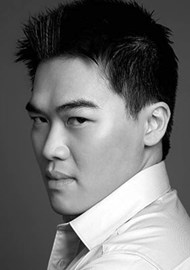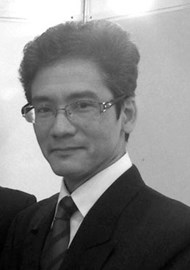
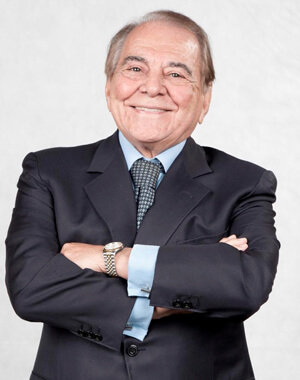
World renowned Plastic Surgeon Ivo Pitanguy passed away on 6 August 2016 at the age of 93 just a day after carrying the Olympic torch for the Rio Games. Read on to learn about the life of this giant of the field, based on an interview from a few years before his death.
Ivo Pitanguy, MD, was born in 1926 in Minais Gerais, Brazil. The son of a general surgeon, Pitanguy followed in his father’s footsteps. He studied under JJ Longacre, MD, of Cincinnati; Marc Iselin, MD, of Paris; and Sir Archibald McIndoe and his cousin, Sir Harold Gillies, in the United Kingdom.
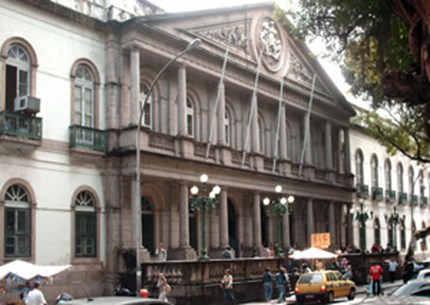
Upon his return to Brazil, Pitanguy set up the first hand-surgery service in Latin America at the 19th Infirmary at the Santa Casa General Hospital in Rio de Janeiro, Brazil. He also became the head of the Department of Burns and Plastic Surgery at Souza Aguiar Hospital in Rio de Janeiro, Brazil.
In 1960, Pitanguy opened the 38th Infirmary Santa Casa de Misericórdia Department of Plastic and Reconstructive Surgery in Rio de Janeiro. The 38th Infirmary, in conjunction with the Clinica Ivo Pitanguy, became a centre of excellence for the training of international plastic surgeons.
Truly ahead of his time, Pitanguy pioneered innovative techniques in plastic surgery and founded a formal residency programme to disseminate and share his vast knowledge. At the 38th Infirmary Pitanguy and his residents frequently dealt with disfigurements among the poor, for example treating the surviving victims of a fire at a circus near Rio in 1961 that claimed the lives of over 500 people. Pitanguy believed that aesthetic surgery is not separate from reconstructive surgery and that even the poor had a right to treatment. At the 38th Infirmary, aesthetic surgery was formally taught and given equal importance to other reconstructive work such as burns, congenital defects and hand surgery. Many surgeries were heavily subsidised and even free for patients unable to afford payment.
By the 1970s Pitanguy had made Rio a mecca for plastic surgery. Pitanguy famously treated the burns suffered by the Formula One driver Niki Lauda in a crash in 1976. Known then as the ‘Michelangelo of the scalpel’, Pitanguy was possibly the most famous plastic surgeon in the world throughout the 1980s and 90s. His client list was rumoured to include Zsa Zsa Gabor, François Mitterand, Sophia Loren, Brigitte Bardot, Elizabeth Taylor, Jackie Onassis, Frank Sinatra, Ivana Trump and even Tom Cruise.
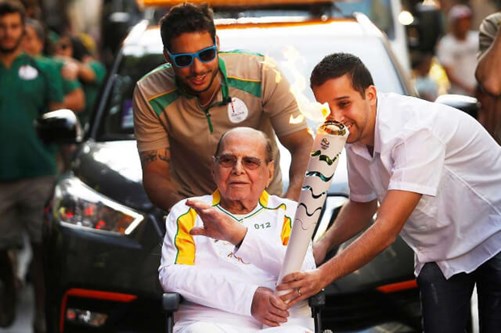
Ivo Pitanguy died of a heart attack at home in Rio de Janeiro. Just a day prior, he had held the torch in the Rio neighbourhood of Gavea, on the final leg of the Olympic relay. Pitanguy was simply known to us, his colleagues, as ‘The Professor’ and his demise after a long and illustrious career was a great loss to the entire plastic surgery community. Perhaps the lasting legacy left by Pitanguy are the graduates from his residency training programme – over 600 surgeons from 42 different countries.
In conversation with Ivo Pitanguy
Why did you choose plastic surgery?
After qualifying as a general surgeon, I worked in an emergency hospital in Rio de Janeiro for three years. I noticed that although emphasis was given to life-saving procedures, little importance was given to restoring a ‘normal’ appearance. For example, a man’s face could have been slashed by a knife, but the subsequent stigma of the scarring was not considered important. To fight to have a normal appearance was not considered necessary in that era. And it was at that time that I realised I wanted to improve my knowledge to be able to perform surgery to restore not just form and function, but also a normal appearance.
At that time, there were no formal residency programmes in plastic surgery. We had to learn by going to different places. I went to learn under Dr John Longacre, a distinguished plastic surgeon in Cincinnati who also worked with Sir Harold Gillies in London. This was in the 1950s. I realised I liked the detail and creativity that could allow the surgeon to restore an appearance closer to normality. This is what plastic surgery is all about.
I returned to Brazil and worked in many hospitals and services trying to apply the various flaps and techniques that I learned. However, I felt I needed to learn more. I went to France to learn under Marc Iselin, a hand surgeon, and others in Paris. After my stint in France, I won a scholarship from the British Council and went to England to learn under Sir Harold Gillies. It was here that I met David Ralph Millard, Jr, MD, a visiting surgeon in England. I also studied under Sir Archibald McIndoe, who instilled the importance of aesthetic surgery in me. At that time, aesthetic surgery was not taught in public hospitals, just private practices, where Dr McIndoe and many others were kind enough to invite and teach me.
When I returned to Brazil, I felt that I had a responsibility to share the knowledge that I gained from the masters. I believed that aesthetic surgery should not only be available to the elite, but to everyone. A deformity should not just be judged by its appearance. The psychological impact also matters.
I set up the Ivo Pitanguy Clinic in Rio de Janeiro because I realised I needed a structure to be able to teach and transmit knowledge. I set up a library and auditorium with a secretary. I also started a department at a teaching hospital in Santa Casa General Hospital in Rio de Janeiro to treat patients with various deformities and aesthetic concerns.
A formal residency programme in plastic surgery was offered. I trained many residents who, in turn, became professors and instructors in my department. Of course, we don’t gain anything by this except the opportunity to teach. In my opinion, aesthetic and reconstructive surgery are one. We cannot separate one from another. What gives me great joy is when those who have been trained by me become teachers themselves not only in Brazil, but also in many other countries.
Tell us what you learned from the luminaries you studied with.
JJ Longacre: In general surgery, one often rushes to complete a surgery very quickly. But in plastic surgery, one has to be very meticulous and patient.
Sir Harold Gillies: When I first met him, he said, “I’ve never seen a Brazilian,” and he looked at me from head to toe like a novelty. He was a great man. He taught me the joy of teaching. He was the one who gave me that pleasure. To teach is one thing, but to like to teach is another. For Sir Harold Gillies, teaching was pleasurable and something he enjoyed.
Sir Archibald McIndoe: He taught me to understand the structure before even touching it. For example, understanding the nose inside and out, interpreting what needs to be done, and respecting what can or cannot be done within the nasal form and anatomy is essential. That had a great impact on me.
Marc Iselin: He taught me about the French culture’s way to treat a patient, approaching them not just as a doctor, but also as a human being, giving life and hope.
In life, I am always learning; we are always learning. We should always be open to knowledge.
Why is broad-based training in plastic surgery so important?
When you are going to do plastic surgery, you need to have a broad vision of the specialty. The challenge we face is that services or departments of plastic surgery are becoming very sub-specialised. Just the other day, a patient presented with a secondary hare lip deformity. And my assistant surgeon, who was very well-trained, requested that I perform the case as she had little exposure to hare lip repair.
In my residency programme, my residents rotate through other services or sub-specialties of plastic surgery. Back in my day, a single plastic surgeon would operate on a very broad spectrum of plastic surgery, from trauma and hand to burns to paediatric cases. I had the pleasure of operating on a wide variety of reconstructive cases during my career. In a way, the reconstructive aspects gave me the tools necessary to perform aesthetic surgery.
I believe a plastic surgeon needs a broad formation to have a deeper understanding of reconstructive surgery – like microsurgery, for example. The aesthetic concepts are applied to reconstructive cases, and the reconstructive concepts are applied to aesthetic cases.
How has plastic surgery evolved over the years?
There has been a great improvement in reconstructive surgery. Many modern tools and biologic materials have been developed. In aesthetic surgery, if you try to do too much, the results may not be desirable. There have to be limitations. For example, in the face, if you overdo it, the end result will not be natural. It is a dangerous thing, progress without digestion.
What is the Ivo Pitanguy philosophy of plastic surgery?
In many cases of breast, abdomen, and other types of surgery, you don’t just learn the technique but also need to learn the philosophy. You need to know how to approach the surgery, what to do, and master the technique. Each time you go to a plastic surgery meeting, you will try to adopt a new technique. But if you have a basic knowledge and technique that comes from a solid experience, the procedures we create or adopt will have the best results in our hands. We pass the knowledge to others. After you graduate, you can do whatever you want to do, but you should come out with a solid knowledge of basic principles and apply them.
For example, when I started doing abdominoplasty in the early days, I always made it a point to tighten the muscles. This was one of the main points of my technique. If you follow the basic principles, they give you the possibility of developing other techniques.
What is the secret of your success – talent or hard work?
No talent is needed at all. All you need is a good interpretation of what needs to be done and what you need to do. Even if you have a hand like this [he contorts his right hand in a malformed position] and you interpret the case and operation correctly, you can do it better than someone with well-formed hands. It is a matter of knowing what you are going to do.
If you are not very gifted, do it slowly. And in this way, you can always do it well – if not better – than anyone who does not pay importance to interpretation. Of course, manual dexterity is also important, but even more important is the ability to interpret. Dexterity comes with practice.
Can you define beauty?
Beauty is very difficult to define. Beauty can be looked upon and approached in many different ways, even in a religious way. If you listen to Santo Tomas Aquino, who quotes, “Beauty is a gift from God,” it carries the meaning that if you are not beautiful, you are not gifted from God. But true beauty comes from within. Only “truth” is beautiful.
As the poet John Keats says, “A thing of beauty is a joy forever: its loveliness increases; it will never pass into nothingness.” But one can also say, “beauty lies in the eyes of the beholder.”
The concept of beauty differs based on culture. Voltaire, the French philosopher, quoted, “Ask a toad what beauty is – great beauty. He will tell you that it is his toad wife with two large, round eyes sticking out of her little, flat face, a yellow belly, and a brown back.”
I feel today there is a notion of imposing one culture’s concept of beauty onto another’s. Beauty has been manipulated by marketing. In my opinion, one can be short and one can be tall, but harmonious in many different ways. Everyone has a different biotype. You don’t have to change your biotype to be beautiful. You can aim for a harmonious look with your biotype. A woman doesn’t need to be thin to be beautiful with aesthetic harmony. Ultimately, beauty is a sense of well-being.
As plastic surgeons, we don’t have the ink of the painter, the stone of the sculptor; we don’t have the vocabulary of the poet. We have the creativity and the interaction with others, and with that we learn what we can do, what we can improve, but always acknowledge our limitations.
What matters most?
The most important thing in life is your family. One needs a family regardless of social class. My wife, my daughter, and my sons and close friends are my family. When one cultivates a good close family, one can develop a very good comprehension of life. We are part of the world. So, if we love our family, we should love the world as well. They are our extended family.
Any advice for aspiring surgeons?
If you like and love what you are doing, you should do so with pleasure and love. Do so responsibly on your chosen path, however long it may be, and you will always be happy.
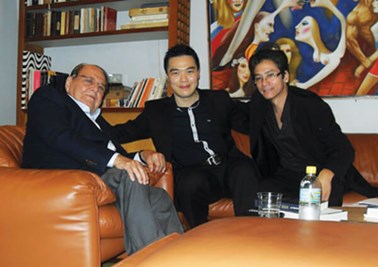
The interview with Ivo Pitanguy was carried out in 2015 by the authors Lee Seng Khoo
and Vasco Senna-Fernandes at Clinica Ivo Pitanguy in Botafogo, Rio de Janeiro
Acknowledgement
This feature is based upon an interview which was first published in February 2015 Plastic Surgery Practice 2015; February: pages 20-21 (Allied Media 360).
COMMENTS ARE WELCOME



